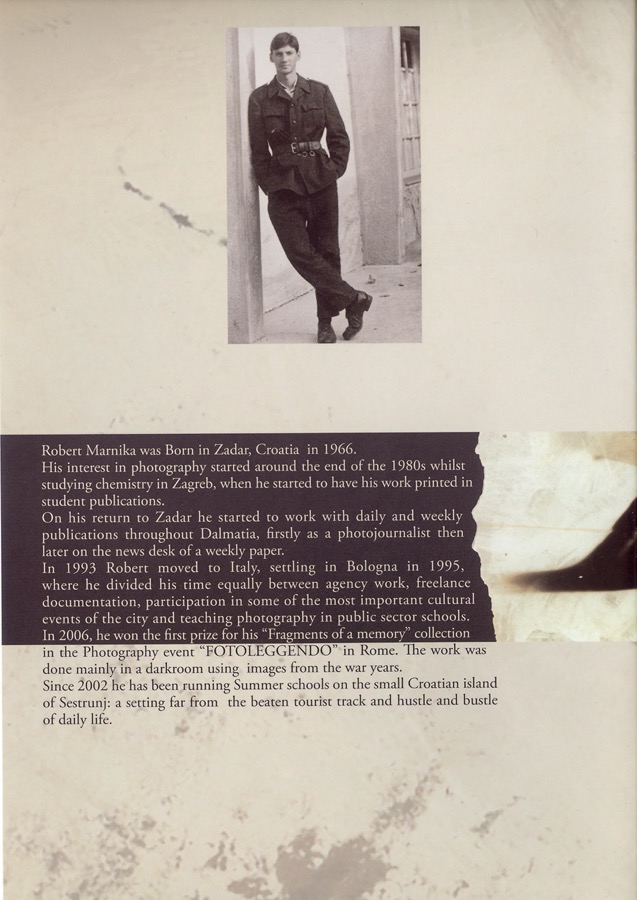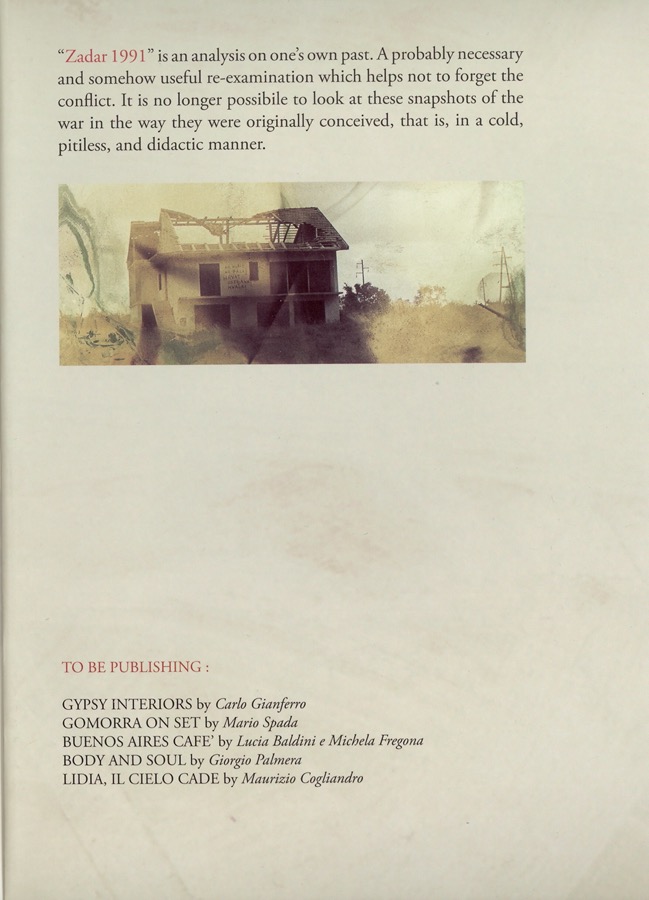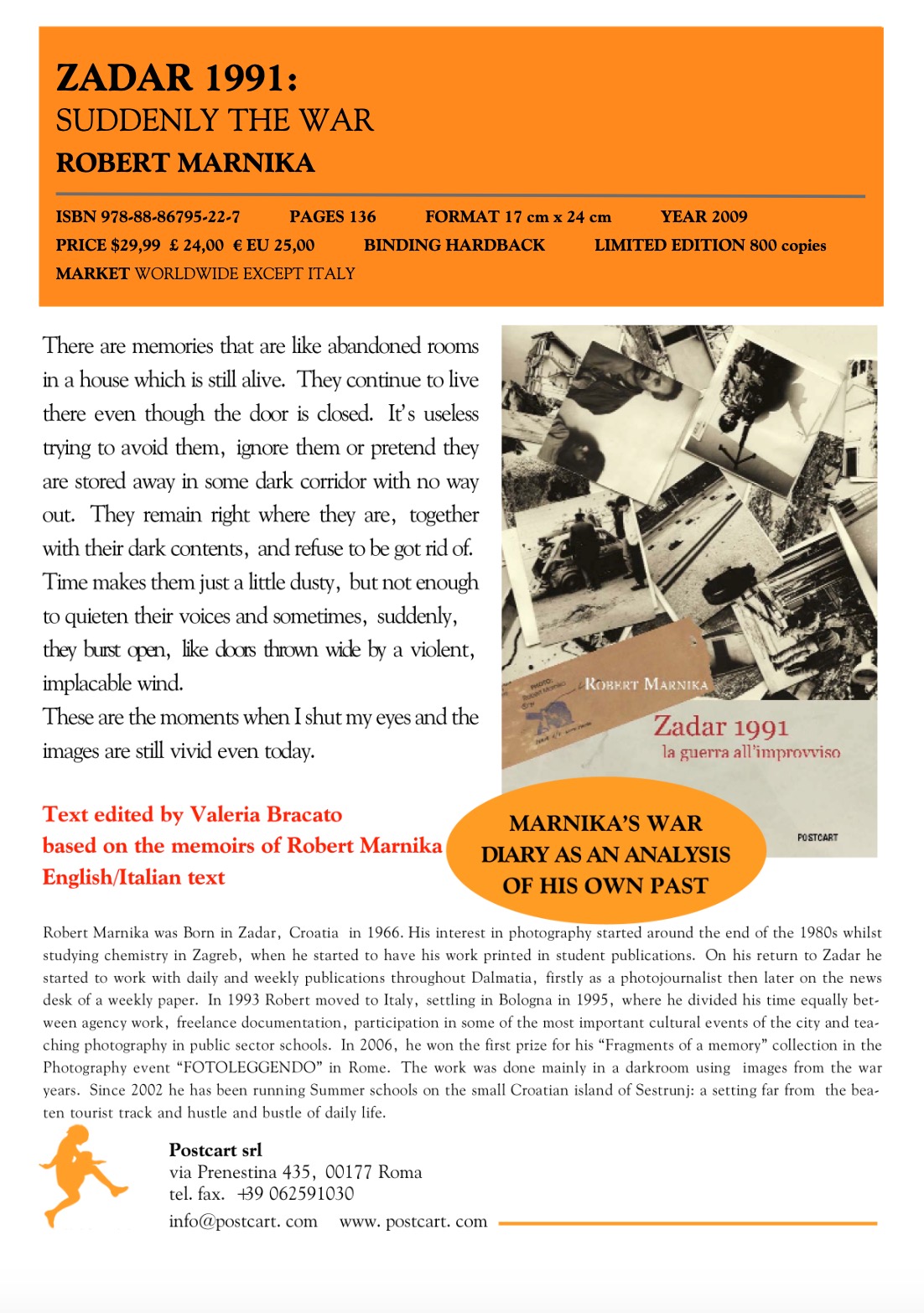Photo book
“ZADAR 1991 THE WAR SUDDENLY”
by Robert marnika
pubblished by postcart EDITORS – ROME
This story is different.
There are many photographers who have documented the endless wars all over our planet as manifestations of the hell which the human race is capable of creating along its path. However, they are almost always reporters who, despite being dramatically involved in the abject reality of destruction and death, have their personal affections, houses and aspirations elsewhere. In some way they are safe.
On the other hand, what Robert Marnika tells of is a wound which has been cut into living flesh and it is the survivor himself who is narrating what happened. It is the elaboration of a tear in his existence, which divides his experiences and memories into ‘before’ and ‘after’. ‘Before’ could have been sweet remembrances of happy moments, but his childhood innocence has been marked by ominous signs of the drama that was to come. ‘After’ becomes a present that both seeks and fears the traces of traumatic memories which he must otherwise accept to forget.
The war is the 1991 to 1995 Yugoslavian conflict, monstrously similar to the hundreds of wars still happening today all over the world. They fall on top of us with disfiguring force, staining the conscience of everyone.
The story we are about to read has a complex structure of mixed languages. The written text is concise. It is as solid as a photograph, intense and powerful as a poem. The succession of words and images follows the flow of memory. Moments overlap, colliding and insisting on belonging to a present which is assailed and threatened by experiences from the past.
The book opens with photos from a family album which slowly bring the artist’s identity to life. His personal data is defiantly confirmed with reproductions of official acts and documents. These are followed by fragile contact with the external world beyond the war in the form of postcards from holiday locations. These brief messages from friends keep ties alive despite the different and distant realities. And moving on there is another contact with an ‘I’ that no longer exists. We see him in the past, surprised and in love. Here he is in the countryside in the vineyards just before the first bombs dropped and there he is in a soldier’s uniform. A moment later war has broken out. Shells fill the photograph as well as our thoughts. And the night in the bunker is sleep filled with grenades and death.
When the pain of memory begins to elaborate itself the images become more opaque, fainter and almost completely erased. They re-emerge from oblivion remaining in a limbo which safeguards the pain. The prints have been immersed in a toning bath, subjected to the stress of acids and man-handling. These are marks created deliberately by the artist. They are his personal and physical re-elaboration of his interior experience. The photographic language used at this point is advanced. It is active and stinging. It is a rebellion in the face of the impossibility to change what has taken place.
Photography becomes a therapeutic act revealing hidden ghosts. It is adept for doing what neither thoughts or words would permit: burning, tearing, obscuring, altering, if only symbolically, what has happened. It can be used to create something new. It is a way of expressing something of oneself and of sharing it by fixing it in time. Enabling you then to move on.
Perhaps we don’t have the right to gain experience through the suffering of others. Distracted and impotent as we are, we look in from the outside. Can we only look in from a distant time and space? If we follow Marnika’s invitation in his heartfelt tale, we can close our eyes and see. In other words, in order to understand we must turn towards our deepest thoughts, towards solidarity and the capability of suffering as one body.
Surely we would like to believe in Susan Sontag’s words, “No-one can think and hit someone at the same time.”[1]
[1] Susan Sontag – Regarding the Pain of Others
Cristina Paglionico
The Italian Federation of Photographic Societies
Link to Gallery HERE
Link to You-Tube video presentation HERE
Link to Editor’s page HERE




